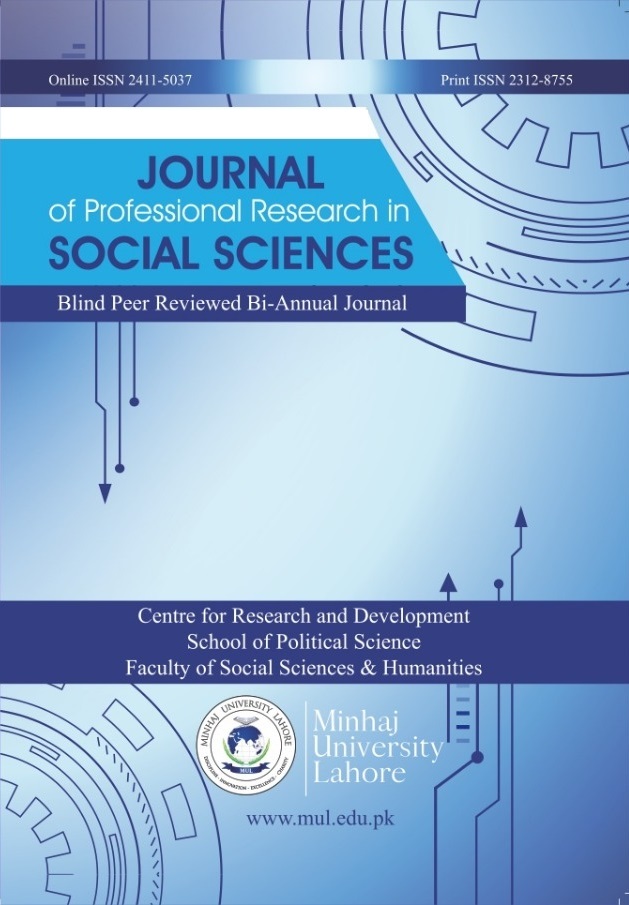Is It Just a Joke? A Qualitative Exploration of Misogyny, Body Shaming and Sexism in Punjabi Stage Dramas
DOI:
https://doi.org/10.58932/MULA0031Keywords:
Women, Objectification, Punjabi Dramas, Sexism, Gender, HumorAbstract
Punjabi stage dramas have been facing a negative reputation in recent years due to the obscenity of content presented in them, hence raising concerns about how they are misrepresenting Punjab’s culture. The humor in these dramas flourishes primarily through the humiliation of the women and objectification of their bodies. The present study aims to analyze how the Punjabi stage dramas objectify women and reinforce the negative gender stereotypes through humor. In order to investigate potential responses to the research question, this study employed a qualitative methodology and an inductive content analysis research technique. Upon closely observing and identifying recurring motifs in stage drama episodes, classifications were established and further analyzed to generate themes. The results of the study uncovered some alarming patterns in Punjabi stage dramas where the female body was sexualized and objectified through the use of different metaphors and jokes. The male characters were noticed mocking the female characters on their physique and especially their breast size, hence perpetuating a repulsive environment of misogyny and sexism. The study also discovered another side of masculinity where subordinate masculine roles were sexually harassed by the hegemonic masculine male characters. The study findings suggest an urgent need for the rectification of these problems by portraying a rather positive and practical image of the female gender that represents the cultural values of Punjab and one where their bodies are not objectified.
References
Abedinifard, M. (2016). Ridicule, gender hegemony, and the disciplinary function of mainstream gender humour. Social semiotics, 26(3), 234-249. https://doi.org/10.1080/10350330.2015.1134817
Akalonu, C.P., Ha, L. The Role of Online Comedy Skits in the Sexual Objectification of Women in Nigeria. Sexuality & Culture (2024). https://doi.org/10.1007/s12119-024-10233-z
Akhlaq Khan, L., Ali, G., Hussain, A., & Noreen, K. (2020). A linguo-cultural analysis of Covid-19 related Facebooks jokes. Linguistics and Literature Review 6 (2), 95-108. https://ssrn.com/abstract=3819556
Akhtar, D. M. I. (2016). Research design. Research Design (February 1, 2016). Doi: 10.12669/pjms.321.9033
Ali, S. (2018). Women objectification and advertising: An analysis of sexually objectified portrayal of women in television advertising in Pakistan. Global Media Journal, 16(31), 1-9. https://www.researchgate.net/publication/334537087_Women_Objectification_and_Advertising_An_Analysis_of_Sexually_Objectified_Portrayals_of_Women_in_Television_Advertising_in_Pakistan
Asghar, M., & Shereen, R. (2021). Punjabi Stage Shows and Contemporary Pakistani Theatre Some Ethnographic Notes. International Review of Social Sciences, 9 (14). https://irss.academyirmbr.com/papers/1618570344.pdf
Awais, M., Rahman, B. H., Ali, F., & Zulfiqar, A. (2020). Laugh Labs and Their Treatment: Analysis of the Satirical Language of Leading Infotainment Programs of Pakistani News Channels. Journal of Media Studies, 35(1). https://openurl.ebsco.com/EPDB%3Agcd%3A11%3A2130059/detailv2?sid=ebsco%3Aplink%3Ascholar&id=ebsco%3Agcd%3A147862816&crl=c
Billig, M. (2005). Comic racism and violence. In Beyond a joke (pp. 25-44). Palgrave Macmillan, London. https://doi.org/10.1057/9780230236776_2
Burmeister, J. M. (2015). Weight-related humor: Effects on expression of attitudes about obesity. Bowling Green State University. http://rave.ohiolink.edu/etdc/view?acc_num=bgsu1433174027
Byrne, M. (2001). Sampling for qualitative research. AORN journal, 73(2), 494-494. https://link.gale.com/apps/doc/A70871448/AONE?u=anon~f72e44ab&sid=googleScholar&xid=e6d80c7e
Chanda, A., & Bansal, S. (2020). The Punjabi Jatt Hero and Other Toxic Masculinities in Punjabi Culture. Feminism in India. https://feminisminindia.com/2020/10/08/punjabi-jatt-hero-toxic-masculinities-punjabi-culture/
Chovanec, J., & Ermida, I. (Eds.). (2012). Language and Humour in the Media. Cambridge Scholars Publishing.
Collinson, M., & Collinson, D. (1996). It's only Dick': the sexual harassment of women managers in insurance sales. Work, Employment and Society, 10(1), 29-56. https://doi.org/10.1177/0950017096101002
Downe‐Wamboldt, B. (1992). Content analysis: method, applications, and issues. Health care for women international, 13(3), 313-321. https://doi.org/10.1080/07399339209516006
Draper, A. K. (2004). The principles and application of qualitative research. Proceedings of the nutrition society, 63(4), 641-646. Doi:10.1079/PNS2004397
Elo, S., & Kyngäs, H. (2008). The qualitative content analysis process. Journal of advanced nursing, 62(1), 107-115. https://doi.org/10.1111/j.1365-2648.2007.04569.x
Flynn, M. A., Craig, C. M., Anderson, C. N., & Holody, K. J. (2016). Objectification in popular music lyrics: An examination of gender and genre differences. Sex roles, 75, 164-176. https://doi.org/10.1007/s11199-016-0592-3
Freberg, K., Graham, K., McGaughey, K., & Freberg, L. A. (2011). Who are the social media influencers? A study of public perceptions of personality. Public Relations Review, 37(1), 90–92. https://doi.org/10.1016/j.pubrev.2010.11.001
Gera Roy, A. (2020). Gendering Dance. Religions, 11(4), 202. DOI: 10.3390/rel11040202
Huda, A. R., & Ali, R. A. (2015). Portrayal of women in Pakistani media. International Journal of Academic Research and Reflection, 3(1), 12-18. https://www.researchgate.net/profile/Roshaan-Amber/publication/340574569_portrayal_of_women_in_pakistani_media/links/5e9184e4a6fdcca7890a5244/portrayal-of-women-in-pakistani-media.pdf
Imam, M.A. et al. (2023) ‘Contextualizing research approaches: The role of Western and Islamic philosophies in shaping methodology and knowledge creation’, Al-Irfan, 8(16), pp. 69–90.
Khan, K. R., & Ali, S. S. (2016). To laugh or not to laugh: A critical Discourse Analysis of the humour employed in Khabardaar. The Journal of Humanities and Social Sciences, 24(1), 25. http://ojs.uop.edu.pk/jhss/article/view/676
Kimmel, M. S. (2010). Masculinity as homophobia: Fear, shame, and silence in the construction of gender identity. In S. R. Harper & F. Harris III (Eds.), College men and masculinities: Theory, research, and implications for practice (pp. 23–31). Jossey-Bass/Wiley
Krippendorff, K. (1980). Content analysis; an introduction to its methodology. Beverly Hills. : SAGE
Kumar, A., Khan, S., & Soni, T. (2023). Happiness and people’s perception towards Indian stand-up and comedy shows: An analytical study of Delhi. World Journal of Advanced Research and Reviews, 17(2), 814-824. https://doi.org/10.30574/wjarr.2023.17.2.0280
Kumari, A., & Joshi, H. (2015). Gender stereotyped portrayal of women in the media: Perception and impact on adolescent. IOSR Journal of Humanities and Social Science (IOSR-JHSS), 20(4), 44-52. DOI: 10.9790/0837-20424452
Marshall, M. N. (1996). Sampling for qualitative research. Family practice, 13(6), 522-526. https://doi.org/10.1093/fampra/13.6.522
Mishra, D. (2015). Portrayal of women in media. Journal of Higher education and research society, 3(2), 122-128. https://www.researchgate.net/profile/Deepanjali-Mishra/publication/a/links/5653052508ae4988a7af3805/PORTRAYAL-OF-WOMEN-IN-MEDIA.pdf
Montemurro, B. (2003). Not a laughing matter: Sexual harassment as “material” on workplace-based situation comedies. Sex roles, 48(9), 433-445. https://doi.org/10.1023/A:1023578528629
Mulvey, L. (2013). Visual pleasure and narrative cinema. In Feminism and film theory (pp. 57-68). Routledge. https://doi.org/10.1023/A:1023578528629
Nayef, H., & El-Nashar, M. (2014). Promoting masculine hegemony through humour: A linguistic analysis of gender stereotyping in Egyptian sexist Internet jokes. International Journal of Linguistics and Communication, 2(4), 69-84. http://dx.doi.org/10.15640/ijlc.v2n4a5
Odukoya, K. A. (2017). Sexualization of women in Nigerian magazine advertisements. International Journal of Humanities and Social Sciences, 11(1), 283–286. doi.org/10.5281/zenodo.1131699
Pamment, C. (2017). Comic performance in Pakistan: the Bhānd. London: Palgrave Macmillan. https://doi.org/10.1057/978-1-137-56631-7
Plester, B. (2015). ’Take it like a man!’: Performing hegemonic masculinity through organizational humour. https://researchspace.auckland.ac.nz/docs/uoa-docs/rights.htm
Purnima, A. (2010). Women's Issues in India: Role and Importance of Media. Global Media Journal, 4(1). http://www.jstor.org/stable/42761809
Ruch, W., Attardo, S., & Raskin, V. (1993). Toward an empirical verification of the general theory of verbal humor. https://doi.org/10.1515/humr.1993.6.2.123
Saleem, R. (2020). Digital Afterlives of Punjabi Stage Dramas. In Reel Pakistan: A Screen Studies Forum (p. 42). https://reelpakistan.lums.edu.pk/sites/default/files/user376/reel_pakistan_vol_4_2022_complete_volume-1.pdf#page=45
Sandelowski, M. (1993). Theory unmasked: The uses and guises of theory in qualitative research. Research in nursing & health, 16(3), 213-218. https://doi.org/10.1002/nur.4770160308
Syeda, F. B. (2015). New media, masculinity and mujra dance in Pakistan (Doctoral dissertation, SOAS, University of London). https://eprints.soas.ac.uk/20357/1/Syeda_4125.pdf
Tyler, M., & Cohen, L. (2008). Management in/as comic relief: Queer theory and gender performativity in The Office. Gender, Work & Organization, 15(2), 113-132. https://doi.org/10.1111/j.1468-0432.2007.00351




